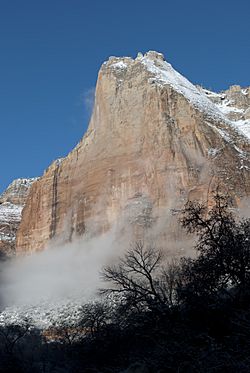Abraham Peak facts for kids
Quick facts for kids Abraham Peak |
|
|---|---|

South face, Abraham peak
|
|
| Highest point | |
| Elevation | 7,014 ft (2,138 m) |
| Prominence | 778 ft (237 m) |
| Isolation | 0.5 mi (0.80 km) |
| Geography | |
| Topo map | USGS Springdale East |
| Geology | |
| Age of rock | Jurassic |
| Mountain type | Monolith |
| Type of rock | Navajo Sandstone |
Abrahams Peak is a huge rock formation located in Zion National Park. This park is found in southwestern Utah, United States. The peak stands about 2,000-foot (610 m) tall.
You can reach Abraham Peak from the main park road. Just follow the Sand Beach Trail. It is the tallest of three peaks known as the Court of the Patriarchs. Another famous peak nearby is The Sentinel.
How Abraham Peak Got Its Name
A long time ago, a geologist named John Wesley Powell explored this area. He first called the park Mukuntuweap National Monument. Today, "Mukuntuweap" is the name of a climbing route on the peak.
The park's name was changed to Zion in 1918. An explorer named Frederick Samuel Dellenbaugh helped make the park famous. He wrote and drew pictures about it for a magazine.
In 1916, a minister named Frederick Vining Fisher visited the park. He was with two young people from the Latter-Day Saints church. Together, they gave names to many of the peaks in the park. They chose names from the Bible.
One of the young people, Claud Hirschi, suggested the name for the tallest peak. He named it after Abraham, an important figure from the Bible.
Climbing Abraham Peak
Abraham Peak is a popular spot for rock climbing. The south side of the peak has two main climbing paths.
- Pangea is on the right side of the rock face. It is about 1,800 feet long.
- Mukuntuweap is on the left side. This route is about 2,000 feet long.
There are also other climbing paths. These are often small changes or nearby ways to climb the Pangea route.



